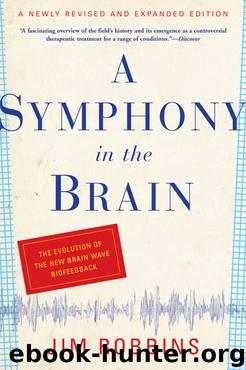A Symphony in the Brain by Jim Robbins

Author:Jim Robbins
Language: eng
Format: epub
Publisher: Grove/Atlantic, Inc.
CHAPTER EIGHT
A Return to Deep States
In 1990, biofeedback practitioners at the annual meeting of the Association of Applied Psychophysiology and Biofeedback in Washington, D.C., were jolted awake in their seats when Dr. Eugene Peniston, a distinguished, soft-spoken clinical psychologist and one of the few African-Americans in the field of biofeedback, gave a talk on an unusual research project. In a cadence more like a Baptist preacher's than a research scientist's, Peniston described research that he and Paul J. Kulkosky, from the University of Southern Colorado, had conducted on alcoholics at the Fort Lyon, Colorado, Veterans Hospital, using techniques they had learned at the Menninger Clinic, the bastion of early deep-states biofeedback. The protocol guided users into a deep, trancelike state where alpha waves and theta waves, which signify deep relaxation, are elevated. Peniston found that those frequencies promoted a healing state that could be used to treat many things, from alcoholism to drug addiction to depression.
The controlled, randomized study used thirty men. Twenty were chronic alcoholics who were drinking themselves to death, all veterans and all back in the hospital for one more in-patient treatment regimen for alcoholism. These patients were divided into two groups. Ten were given conventional talk therapy treatment and took part in the twelve-step process, while ten others were given all of the traditional therapies, as well as a series of novel treatments that has since become known as the Peniston protocol. A third control group of ten non-alcoholics was also included. They received no treatment but had all the measurements taken.
First, the experimental group was given eight relaxation training sessions with standard hand-warming biofeedback. Members of the group were instructed in relaxation techniques until they could raise their fingertip temperature—cold hands are a symptom of anxiety—to 95 degrees in two consecutive sessions. Then they were given something called alpha-theta brain wave neurofeedback therapy. As is the case with beta and SMR training, alpha-theta uses a computer or analog instrument to guide users to a specific frequency or range of frequencies and hold them in that range. Yet alpha-theta is a very different approach. While beta and SMR can be thought of as more of a physiological approach, strengthening the cortex to alleviate symptoms and not concerned with their cause, alpha-theta training derives from the psychotherapeutic model. Lying back in a recliner with eyes closed, clients allow a therapist's voice and sounds from a neurofeedback instrument to guide them into a deeply relaxed “alpha-theta crossover” state in the alpha (8-12 hertz) and the theta (4-8 hertz) range, right on the edge of sleep. The active ingredient of the training, many believe, is the imagery of painful, repressed memories that the client has suffered with for years, which surface and are then resolved in this state. The name comes from the behavior of the brain waves being shown on the screen. Alpha waves are usually higher in amplitude, or more powerful, than theta. When, during this therapy, the amplitude of the alpha waves drops and the theta
Download
This site does not store any files on its server. We only index and link to content provided by other sites. Please contact the content providers to delete copyright contents if any and email us, we'll remove relevant links or contents immediately.
Periodization Training for Sports by Tudor Bompa(7929)
Why We Sleep: Unlocking the Power of Sleep and Dreams by Matthew Walker(6362)
Paper Towns by Green John(4805)
The Immortal Life of Henrietta Lacks by Rebecca Skloot(4262)
The Sports Rules Book by Human Kinetics(4079)
Dynamic Alignment Through Imagery by Eric Franklin(3925)
ACSM's Complete Guide to Fitness & Health by ACSM(3827)
Kaplan MCAT Organic Chemistry Review: Created for MCAT 2015 (Kaplan Test Prep) by Kaplan(3804)
Introduction to Kinesiology by Shirl J. Hoffman(3628)
Livewired by David Eagleman(3535)
The River of Consciousness by Oliver Sacks(3420)
The Death of the Heart by Elizabeth Bowen(3342)
Alchemy and Alchemists by C. J. S. Thompson(3298)
Descartes' Error by Antonio Damasio(3167)
Bad Pharma by Ben Goldacre(3102)
The Emperor of All Maladies: A Biography of Cancer by Siddhartha Mukherjee(2932)
The Gene: An Intimate History by Siddhartha Mukherjee(2929)
The Fate of Rome: Climate, Disease, and the End of an Empire (The Princeton History of the Ancient World) by Kyle Harper(2877)
Kaplan MCAT Behavioral Sciences Review: Created for MCAT 2015 (Kaplan Test Prep) by Kaplan(2819)
